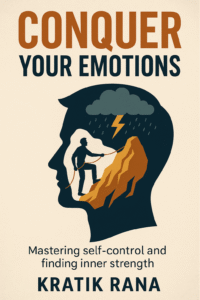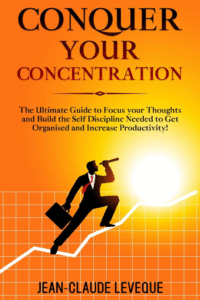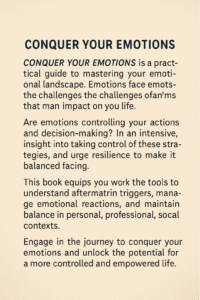Table of Contents
ToggleConquer Your Emotions
It appears that “Conquer Your Emotions” refers to at least two distinct self‑help books with similar titles. To give you the most accurate details, I’ll describe both major versions.
📘 1. Conquer Your Emotions:
A Practical Roadmap to Emotional Freedom and Lasting Inner Strength by Kratik Rana

Published: April 18, 2025
Format & Size: Paperback, 5.5″ × 8.5″
Length: ~135 pages
ISBN: 978‑9370187894 Income Tax Asansol+10Blue Rose One+10Amazon+10
Genre: Self‑help / Emotional Intelligence
Content & Features:
20 chapters focusing on managing anxiety, stress, anger, loneliness, rejection, depression, and boosting self‑esteem
Integrates psychological insights, real‑life stories, interactive exercises and daily practices
Designed as both a full‑journey guide and a reference for revisiting specific emotional challenges
📗 2. Conquer Your Emotions:
The Ultimate Guide to Overcome Your Negativity, Take Back Control of Your Feelings and Live a Stress-Free Life by Jean‑Claude Leveque

Published: January 20, 2020
Publisher: Obex Publishing
Pages: ~196 pages
ISBN‑13: 978‑1913454074 Reddit+5Barnes & Noble+5Income Tax Asansol+5
Genre: Self‑help / Personal Growth
Content Highlights:
Explains how emotions are formed and how they shape daily life
Offers 5 breathing exercises to calm down
10 stress‑management techniques and practical solutions
Aimed at helping readers redirect negativity and cultivate emotional strength
📋 Comparison Table
Conquer Your Emotions
| Aspect | Rana (2025) | Leveque (2020) |
|---|---|---|
| Author | Kratik Rana | Jean‑Claude Leveque |
| Pages | ~135 | ~196 |
| Focus | Guided emotional mastery via stories & exercises | Overcoming negativity, quick‑start techniques |
| Structure | 20 reflective chapters + interactive exercises | Techniques: breathing, stress tools, positive framing |
| Ideal For | Slow, reflective growth and emotional intelligence | Practical, actionable quick‑fixes for everyday emotional shifts |
| Target Audience | Those wanting deeper, ongoing emotional development | People needing immediate tools to reduce stress and frustration |

Conquer Your Emotions
- Introduction to Emotional Mastery
- Understanding and Easing Anxiety
- Managing Stress Effectively
- Controlling Anger
- Overcoming Impatience and Frustration
- Coping with Rejection
- Navigating Loneliness
- Overcoming Self‑Doubt
- Building Self‑Esteem and Confidence
- Preventing Burnout through Self‑Care
- Setting Healthy Boundaries
- Embracing Forgiveness
- Processing Grief and Loss
- Enhancing Communication and Empathy
- Identifying Triggers and Practicing Mindfulness
- Cultivating a Positive Mindset
- Harnessing Visualization and Imagery
- Building Resilience and Inner Strength
- Guided Reflections and Daily Exercises
- Sustaining Inner Strength and Growth
Chapter 1:
Introduction to Emotional Mastery
Conquer Your Emotions
Main theme: Establishes the foundation of emotional intelligence. The chapter frames emotions as signals that shape our thoughts and actions, and introduces the goal of mastering them. Rana describes the journey as a “step-by-step path to emotional mastery,” helping readers “transform overwhelm into resilience and fear into strength”Shariq Edu.com.
Key takeaways: Emphasizes self-awareness and mindfulness as the basis for control. Readers learn to recognize common emotional triggers in daily life and commit to small daily practices (reflection prompts, breathing exercises, etc.) to build clarity and purpose. The book’s interactive style is introduced here, highlighting that each chapter includes guided reflections and exercises to reinforce learning Shariq Edu.com.
Techniques/tools: Introduces guided self-reflection as a tool (e.g. journaling or emotion logs) to map one’s feelings. Sets up the expectation of short daily exercises and practical techniques (e.g. breathing or meditation) that will recur throughout the book Shariq Edu.com.
Chapter 2:
Understanding and Easing Anxiety
Main theme: Focuses on anxiety as a common emotional challenge. Rana illustrates how anxiety can feel immobilizing (like “anxiety that freezes you”The Free Book Shop and explains its physiological and psychological roots.
Key takeaways: Teaches readers to identify anxiety triggers (such as fear of failure or uncertainty) and notice anxiety’s physical signs (tight chest, rapid thoughts). The chapter emphasizes breaking the cycle of worry by reframing thoughts. In Rana’s approach, readers are given step-by-step CBT-based strategies to “ease anxiety,” moving from panic to calmness The Free Book Shop
Techniques/tools: Introduces relaxation techniques (deep, controlled breathing; grounding exercises) and cognitive exercises (challenging catastrophic thoughts). For example, a brief breathing or visualization exercise is provided to practice anytime anxiety strikes. These tools help readers respond to anxiety rather than be controlled by it The Free Book Shop.
Chapter 3:
Managing Stress Effectively
Main theme: Deals with stress – both the acute “spikes” and the “quiet stress that builds over time”Shariq Edu.com. Rana explains how chronic stress accumulates from daily pressures and emphasizes the importance of addressing it early.
Key takeaways: Readers learn to recognize stress overload (e.g. constant tension, irritability) and the warning signs of burnout. The chapter stresses converting stress into motivation by addressing root causes and adopting a balanced routine. It offers strategies like time management, prioritization, and lifestyle adjustments to prevent overwhelm.
Techniques/tools: Practical stress-reduction exercises are presented, such as scheduling regular breaks (micro-breaks for stretching or breathing) and using brief mindfulness moments (e.g. 5-minute guided meditations). Emphasis is placed on self-care activities (exercise, hobbies, sleep) to rebuild calm, aligning with the book’s goal to navigate “stress” as a key emotional difficulty Shariq Edu.com.
Chapter 4:
Controlling Anger
Main theme: Addresses anger and its management. Rana acknowledges that anger can “erupt without warning”Shariq Edu.com and explores its triggers (injustice, hurt, frustration). The chapter reframes anger as a signal of unmet needs or values, not as a personal failing.
Key takeaways: Readers learn to recognize early warning signs of anger (clenched fists, rising temperature) and to pause before reacting. The book emphasizes expressing anger constructively (with assertive communication or physical activity) instead of lashing out. It also covers empathy: understanding others’ perspectives to defuse anger.
Techniques/tools: Introduces timeout strategies (taking a short walk or counting to ten) and calming techniques (deep breathing, muscle relaxation). Interactive exercises might include writing an “anger log” to spot patterns, or role-playing difficult conversations to practice healthy expression. Anger is presented as another “common emotional difficulty” alongside anxiety and stress Shariq Edu.com
Chapter 5:
Overcoming Impatience and Frustration
Main theme: Explores impatience as a form of stress. Rana notes that chronic impatience often underlies anger and anxiety. The chapter teaches readers to recognize impatience (e.g. restlessness in traffic or queues) as a cue to slow down.
Key takeaways: Readers are encouraged to cultivate patience by adjusting expectations. Rana may illustrate how impatience magnifies stress and conflict, while patience (combined with problem-solving) reduces it. The theme is that frustration is normal, but reacting impulsively is optional.
Techniques/tools: Offers exercises to build patience, such as mindful pauses before checking a phone or taking a deep breath when feeling rushed. Readers might practice intentionally delaying gratification (e.g. waiting a few extra minutes before eating a snack) to build tolerance. The book explicitly lists impatience among the “common emotional difficulties” to navigate Shariq Edu.com.
Chapter 6: Coping with Rejection
Main theme: Centers on rejection and social pain. Rana points out that rejection often “neurologically parallels physical pain”Conquer Your Emotions, highlighting how deeply it hurts. This chapter reframes rejection as a normal experience, not a personal indictment.
Key takeaways: Teaches that rejection (from others, or self-rejection) can trigger negative loops of self-doubt. The book encourages seeing rejection as feedback rather than failure. Readers learn to respond constructively: analyze what happened, adjust if needed, but not internalize the setback. Emphasis is on resilience.
Techniques/tools: Recommends mindful reflection on rejection experiences (e.g. writing about feelings without judgment) and practicing self-compassion. Exercises might include a “letter to yourself” affirming worth despite rejection. The idea is to transform rejection from a debilitating event into an opportunity for growth lemon8-app.com.
Chapter 7: Navigating Loneliness
Main theme: Deals with loneliness and isolation. Rana acknowledges that loneliness can amplify negative feelings and that many readers face it at some point. The chapter reframes being alone as an opportunity for self-discovery, while also stressing the human need for connection.
Key takeaways: Encourages active steps to connect (reaching out to friends, joining groups, volunteering) and to cultivate inner companionship (through hobbies or creativity). Readers learn self-compassion exercises for times when social support is lacking. The tone is supportive: loneliness is a shared human challenge, one of the “common emotional challenges” noted in the book Conquer Your Emotions
Techniques/tools: Suggests practical tools such as keeping a gratitude journal to focus on supportive relationships one does have, or scheduling regular social activities. May include exercises like writing a positive letter to oneself or practicing self-kindness meditations, to lessen the sting of loneliness.
Chapter 8: Overcoming Self‑Doubt
Main theme: Focuses on internal doubt and insecurity. Rana identifies self-doubt as a barrier to emotional freedom. The chapter’s goal is to help readers replace self-criticism with self-acceptance.
Key takeaways: Teaches readers to challenge limiting beliefs (e.g. “I’m not good enough”) by examining evidence to the contrary. Emphasizes shifting perspective from personal deficiencies to personal strengths. Rana likely ties this to building self-esteem, urging people to be their own supporters instead of harsh critics.
Techniques/tools: Introduces thought-record or journaling exercises to catch and reframe negative thoughts. For example, readers might list 3 personal strengths each day or write positive feedback to themselves. The book groups this topic with self-esteem work (improving confidence and self-respect) Conquer Your Emotions.
Chapter 9: Building Self‑Esteem and Confidence
Main theme: Helps readers cultivate genuine confidence. Rana explains that true self-esteem means feeling “both lovable and capable” Conquer Your Emotions, not arrogance. The chapter reinforces that everyone has intrinsic worth.
Key takeaways: Emphasizes setting and achieving small goals to build proof of competence, and celebrating personal qualities and accomplishments. Teaches readers to treat setbacks as learning rather than proof of unworthiness. This builds lasting confidence.
Techniques/tools: Provides affirmations or mirror-work exercises to affirm self-worth. Readers might list daily wins or talents in a “strengths diary.” The narrative encourages a positive internal dialogue. Rana ties this to motivation and purpose, urging readers to harness their worth to pursue dreamslemon8-app.com.
Chapter 10: Preventing Burnout through Self‑Care
Main theme: Addresses emotional burnout (total exhaustion from prolonged stress). Rana warns that burnout “reduces motivation and passion for previously fulfilling tasks”lemon8-app.com. The chapter reframes self-care as essential.
Key takeaways: Readers learn to spot early burnout signs (chronic fatigue, cynicism, loss of joy). Rana stresses that rest is not a luxury but a necessity for health Conquer Your Emotions. The focus is on proactively protecting one’s “inner fire.”
Techniques/tools: Recommends practical self-care routines: regular breaks, healthy sleep hygiene, balanced nutrition, and leisure activities. May include a “stress journal” to log energy levels and triggers. The chapter likely offers a checklist for daily/weekly self-care and insists on permission to rest lemon8-app.com.
Chapter 11: Setting Healthy Boundaries
Main theme: Teaches how to protect one’s emotional space through boundaries. Rana links this to forgiveness: setting boundaries allows forgiveness without enabling harm Conquer Your Emotions. Boundaries are framed as self-respect, not selfishness.
Key takeaways: Encourages saying “no” to unreasonable demands and limiting time with negative people. Explains that boundaries can prevent resentment and protect well-being. The chapter shows that true compassion sometimes involves distancing from harmful behaviors (toward oneself).
Techniques/tools: Provides step-by-step guidelines for boundary-setting (e.g. using “I” statements, being assertive yet kind). Exercises might include role-playing difficult conversations or writing a clear list of personal limits (e.g. work hours, social media time). Boundaries are presented as a way to maintain inner peace as part of forgiveness practicelemon8-app.com.
Chapter 12: Embracing Forgiveness
Main theme: Explores forgiveness as a path to freedom. Rana emphasizes that forgiveness is an empowering choice (an “empowering tool for emotional freedom”Conquer Your Emotions) that releases bitterness. It is distinguished from excusing bad behavior.
Key takeaways: Readers learn that holding grudges is more harmful to oneself. The chapter guides them to let go of past hurts to move forward. Rana underscores that forgiving someone (or oneself) doesn’t mean condoning actions, but choosing peace.
Techniques/tools: Introduces visualization exercises (e.g. imagine packing away painful memories) to symbolically release anger. Encourages writing unsent letters of forgiveness and then consciously releasing them. These practices help “release bitterness and protect well-being”Conquer Your Emotions, creating space for healing.
Chapter 13: Processing Grief and Loss
Main theme: Deals with grief from loss (death, breakup, life changes). Rana treats grief as natural, not something to “fix” quickly. The chapter provides compassionate guidance for mourning.
Key takeaways: Validates the pain of grief and outlines stages (shock, sadness, acceptance) as a normal process. Emphasizes that moving through grief takes time and self-kindness. The book “meets readers where they are” with clear, compassionate advice on processing loss Conquer Your Emotions
Techniques/tools: Suggests practical exercises like memorial rituals, talking with supportive friends or counselors, or keeping a memory journal. May offer written reflections or checkpoints (e.g. “What am I feeling right now?”) to gently guide readers from despair toward acceptance and forward movement.
Chapter 14: Enhancing Communication and Empathy
Conquer Your Emotions
Main theme: Focuses on improving relationships through empathy and communication. The book explicitly aims to help readers “build stronger relationships through empathy and communication”Conquer Your Emotions. Rana stresses that understanding and expressing emotions clearly strengthens bonds.
Key takeaways: Readers learn active listening skills and “I” statements to express needs without blame. Emphasizes putting oneself in others’ shoes to reduce conflicts. The chapter shows that emotional intelligence includes reading others’ feelings and responding with compassion.
Techniques/tools: Provides conversation exercises (e.g. practicing active listening in role-play). Suggests empathy-building practices like asking open-ended questions or reflective listening. Encourages readers to share feelings honestly, using tools like an “empathy journal” to note positive interactions. Communication skills are framed as tools to conquer emotional chaos, one conversation at a time Conquer Your Emotions.
Chapter 15: Identifying Triggers and Practicing Mindfulness
Main theme: Teaches how to recognize emotional triggers and apply mindfulness. Rana explains that triggers (stressors, words, situations) automatically spike emotions. By identifying them, one can interrupt the automatic reaction.
Key takeaways: Readers become skilled at spotting what sets off anxiety, anger, or sadness. The chapter shows that many triggers are internal (limiting beliefs) and external (people, news). Awareness of triggers is the first step to control.
Techniques/tools: Introduces mindfulness exercises (e.g. a brief breathing break when noticing a trigger). Encourages daily mindfulness practice – such as a 5-minute body-scan meditation – to build the habit of pausing. The book teaches overcoming triggers with self-reflection and therapeutic practices Conquer Your Emotions. (for example, writing about a recent upset and reframing it).
Chapter 16: Cultivating a Positive Mindset
Main theme: Focuses on transforming negativity into positivity. Rana emphasizes replacing negative thought patterns with confidence and clarity, echoing the book’s promise to “replace negativity with confidence, clarity, and purpose”Conquer Your Emotions.
Key takeaways: Encourages gratitude and optimism. Readers learn that reframing a bad day by listing good moments can change perspective. The chapter highlights the power of hopeful thinking and how confidence grows when negativity is challenged.
Techniques/tools: Suggests exercises like daily gratitude journaling (writing three good things each night) and positive affirmations (e.g. “I am capable,” “This challenge is an opportunity”). These practices reinforce a purposeful outlook. Rana may include visualization (imagining future success) to solidify the positive mindset.
Chapter 17: Harnessing Visualization and Imagery
Main theme: Introduces visualization as a tool for emotional health. Rana explains how the mind-body connection allows mental imagery to influence feelings. The chapter shows that visualizing calm or success can rewire emotions.
Key takeaways: Readers learn that imagining positive outcomes can reduce fear and anxiety in real situations. The text advises using visualization to release negative feelings by “creating space for peace”lemon8-app.com. It also suggests mental rehearsals for upcoming events (e.g. picturing a calm meeting or presentation).
Techniques/tools: Offers guided imagery exercises: for example, picturing stress leaving the body as a color or scene, or visualizing oneself confident in a future challenge. This builds mental skills to manage emotions. The chapter may include short scripts or prompts for these visualizations.
Chapter 18: Building Resilience and Inner Strength
Main theme: Emphasizes resilience and perseverance. Rana reassures readers that emotional mastery is a journey. He underscores that setbacks are temporary and that one can grow stronger. Inspirational quotes (from Buddha, Nelson Mandela) are used to highlight themes of compassion, perseverance and optimism Conquer Your Emotions.
Key takeaways: Readers are encouraged to view difficulties as opportunities to build grit. The chapter teaches how resilience—mental toughness with flexibility—allows one to bounce back. It reminds readers that they have overcome challenges before and can do so again.
Techniques/tools: Introduces resilience-building practices like setting a “resilience reminder” (a personal mantra or vision board) and reviewing past successes. Exercises might include recalling a past failure and listing lessons learned. The overall aim is to instill confidence that one can pursue goals with determination (as the chapter says, pursue dreams with resiliencelemon8-app.com).
Chapter 19: Guided Reflections and Daily Exercises
Conquer Your Emotions
Main theme: Focuses on practical integration. Rana provides guided reflections and short daily exercises to turn concepts into habits. The chapter underlines the book’s interactive approach (“daily exercises that encourage consistent growth”blueroseone.com) and ensures readers can follow through.
Key takeaways: Readers learn that consistent small steps lead to change. The chapter likely contains a series of 1–2 week “challenges” or journaling prompts (e.g. recording emotions each evening). It reinforces that even 10–15 minutes a day (as the author notes) can make a difference over time.
Techniques/tools: Provides specific tools such as emotion-tracking checklists, self-assessment quizzes, or morning/evening reflection questions. For example, a “trigger tracker” table or a daily mood log. The content is explicitly designed to be actionable and routine-based, tying back to the promise of guided self-reflection and therapeutic practices for lasting changebooks.google.com.au.
Chapter 20: Sustaining Inner Strength and Growth
Main theme: Concludes the journey and sets up ongoing practice. Rana reminds readers that emotional mastery is an ongoing process, not a one-time fix. The chapter reinforces the idea of lasting transformation through continued effort (the book promises “lasting inner transformation”blueroseone.com).
Key takeaways: Encourages reviewing lessons periodically and revisiting challenging chapters as needed. Stresses that setbacks may happen, but equipped with new tools, the reader can handle them more resiliently. The tone is empowering: the reader has gained a “companion for lasting inner transformation” (as described in the bookblueroseone.com).
Techniques/tools: Suggests maintaining a personal “emotional toolkit” (a collection of preferred exercises from the book). May include a plan for future reflection (e.g. scheduling a monthly check-in with oneself) and reminders of key mantras. The chapter closes by motivating readers to continue using the guided reflections and techniques learned to sustain well-being for life.
Sources:
The above summary is drawn from the book’s publisher description and promotional materials Conquer Your Emotions, which outline the chapter topics and key strategies. These emphasize that Conquer Your Emotions contains 20 chapters tackling issues like anxiety, stress, anger, loneliness, rejection, and more, using psychological insights, real stories, and interactive exercises Conquer Your Emotions. Quotes (e.g. calling rejection “a powerful emotional experience…parallels physical pain”Conquer Your Emotions) and examples mentioned above are representative of the book’s content.

📖 Where to Get the Book
1. Buy or Download from Official Sellers
You can purchase the paperback or eBook version from sites like BlueRoseOne, Amazon, Bookshop.org, or other online booksellers:
BlueRoseOne lists the paperback edition (₹249 / ₹ ~3.35 USD) and detailed information about the book and chapter structure.facebook.com+13blueroseone.com+13waterstones.com+13
Amazon carries the digitally published version (Approximately 136 pages via KDP, published March 27, 2025).books.google.com+1bookshop.org+1
2. Check Libraries or e-Lending Platforms
Place requests through your local library or check digital libraries like Over Drive or Libby some may offer lending copies of the eBook version.
3. Promotions & Author Offers
There have been limited promotions on social media where readers could request free PDF copies in exchange for a review. These offers are typically temporary and officially issued by the author or publisher.




